| Weight | 1 lbs |
|---|---|
| Dimensions | 9 × 5 × 2 in |
| host | mouse |
| isotype | IgG1 |
| clonality | monoclonal |
| concentration | concentrate, predilute |
| applications | IHC |
| reactivity | human |
| available size | 0.1 mL, 0.5 mL, 1 mL concentrated, 7 mL prediluted |
mouse anti-E-Cadherin monoclonal antibody (ZM63) 6165
Price range: $160.00 through $528.00
Antibody summary
- Mouse monoclonal to E-Cadherin
- Suitable for: Immunohistochemistry (formalin-fixed, paraffin-embedded tissues)
- Reacts with: Human
- Isotype:IgG1
- Control: Skin or breast carcinoma
- Visualization: Membrane
- 0.1, 0.5, 1.0 mL concentrated, 7 mL prediluted
mouse anti-E-Cadherin monoclonal antibody ZM63 6165
| target relevance |
|---|
| Protein names Cadherin-1 (CAM 120/80) (Epithelial cadherin) (E-cadherin) (Uvomorulin) (CD antigen CD324) [Cleaved into: E-Cad/CTF1; E-Cad/CTF2; E-Cad/CTF3] |
| Gene names CDH1,CDH1 CDHE UVO |
| Mass 97456Da |
| Function FUNCTION: Cadherins are calcium-dependent cell adhesion proteins (PubMed:11976333). They preferentially interact with themselves in a homophilic manner in connecting cells; cadherins may thus contribute to the sorting of heterogeneous cell types. CDH1 is involved in mechanisms regulating cell-cell adhesions, mobility and proliferation of epithelial cells (PubMed:11976333). Promotes organization of radial actin fiber structure and cellular response to contractile forces, via its interaction with AMOTL2 which facilitates anchoring of radial actin fibers to CDH1 junction complexes at the cell membrane (By similarity). Plays a role in the early stages of desmosome cell-cell junction formation via facilitating the recruitment of DSG2 and DSP to desmosome plaques (PubMed:29999492). Has a potent invasive suppressor role. It is a ligand for integrin alpha-E/beta-7. {ECO:0000250|UniProtKB:F1PAA9, ECO:0000269|PubMed:11976333, ECO:0000269|PubMed:16417575, ECO:0000269|PubMed:29999492}.; FUNCTION: E-Cad/CTF2 promotes non-amyloidogenic degradation of Abeta precursors. Has a strong inhibitory effect on APP C99 and C83 production. {ECO:0000269|PubMed:16417575}.; FUNCTION: (Microbial infection) Serves as a receptor for Listeria monocytogenes; internalin A (InlA) binds to this protein and promotes uptake of the bacteria. {ECO:0000269|PubMed:10406800, ECO:0000269|PubMed:17540170, ECO:0000269|PubMed:8601315}. |
| Subellular location SUBCELLULAR LOCATION: Cell junction, adherens junction {ECO:0000269|PubMed:18343367, ECO:0000269|PubMed:22294297, ECO:0000269|PubMed:27760340, ECO:0000269|PubMed:28169360}. Cell membrane {ECO:0000269|PubMed:19403558, ECO:0000269|PubMed:20859650, ECO:0000269|PubMed:28301459}; Single-pass type I membrane protein. Endosome {ECO:0000269|PubMed:15689490}. Golgi apparatus, trans-Golgi network {ECO:0000269|PubMed:15689490}. Cytoplasm {ECO:0000269|PubMed:22294297}. Cell junction, desmosome {ECO:0000269|PubMed:25208567, ECO:0000269|PubMed:29999492, ECO:0000269|PubMed:33596089}. Note=Colocalizes with DLGAP5 at sites of cell-cell contact in intestinal epithelial cells. Anchored to actin microfilaments through association with alpha-, beta- and gamma-catenin. Sequential proteolysis induced by apoptosis or calcium influx, results in translocation from sites of cell-cell contact to the cytoplasm. Colocalizes with RAB11A endosomes during its transport from the Golgi apparatus to the plasma membrane. Recruited to desmosomes at the initial assembly phase and also accumulates progressively at mature desmosome cell-cell junctions (PubMed:25208567, PubMed:29999492). Localizes to cell-cell contacts as keratinocyte differentiation progresses (By similarity). {ECO:0000250|UniProtKB:P09803, ECO:0000269|PubMed:25208567, ECO:0000269|PubMed:29999492}. |
| Tissues TISSUE SPECIFICITY: Expressed in granuloma macrophages (at protein level) (PubMed:27760340). Expressed in the skin (at protein level) (PubMed:22294297). Expressed in the liver (PubMed:3263290). {ECO:0000269|PubMed:22294297, ECO:0000269|PubMed:27760340, ECO:0000269|PubMed:3263290}. |
| Structure SUBUNIT: Homodimer; disulfide-linked (PubMed:11856755). Component of an E-cadherin/ catenin adhesion complex composed of at least E-cadherin/CDH1, beta-catenin/CTNNB1 or gamma-catenin/JUP, and potentially alpha-catenin/CTNNA1; the complex is located to adherens junctions (PubMed:16126725, PubMed:7982500). Found in a complex composed of CDH1, RAP1A and PKP3; PKP3 acts as a scaffold protein within the complex, the complex is required for CDH1 localization to mature desmosome cell junctions (PubMed:25208567). Interacts with the TRPV4 and CTNNB1 complex (By similarity). Interacts with CTNND1 (PubMed:15240885). The stable association of CTNNA1 is controversial as CTNNA1 was shown not to bind to F-actin when assembled in the complex (By similarity). Alternatively, the CTNNA1-containing complex may be linked to F-actin by other proteins such as LIMA1 (By similarity). Interaction with PSEN1, cleaves CDH1 resulting in the disassociation of cadherin-based adherens junctions (CAJs) (PubMed:11226248, PubMed:16126725). Interacts with AJAP1 and DLGAP5 (PubMed:14595118, PubMed:14699157). Interacts with TBC1D2 (PubMed:20116244). Interacts with LIMA1 (PubMed:18093941). Interacts with CAV1. Interacts with PIP5K1C (PubMed:17261850). Interacts with RAB8B (By similarity). Interacts with RAPGEF2 (By similarity). Interacts with DDR1; this stabilizes CDH1 at the cell surface and inhibits its internalization (PubMed:20432435). Interacts with KLRG1 (PubMed:19604491). Forms a ternary complex composed of ADAM10, CADH1 and EPHA4; within the complex, CADH1 is cleaved by ADAM10 which disrupts adherens junctions (By similarity). Interacts with SPEF1 (PubMed:31473225). Interacts with CTNNB1 and PKP2 (PubMed:11790773). Interacts with AMOTL2; the interaction may facilitate binding of radial actin fibers to cell junction complexes (By similarity). Interacts with DSG3; the interaction is required for CDH1 localization to developing adherens junctions (PubMed:22294297). {ECO:0000250, ECO:0000250|UniProtKB:F1PAA9, ECO:0000250|UniProtKB:P09803, ECO:0000250|UniProtKB:Q9R0T4, ECO:0000269|PubMed:11226248, ECO:0000269|PubMed:11790773, ECO:0000269|PubMed:11856755, ECO:0000269|PubMed:12526809, ECO:0000269|PubMed:14595118, ECO:0000269|PubMed:14699157, ECO:0000269|PubMed:15240885, ECO:0000269|PubMed:16126725, ECO:0000269|PubMed:17261850, ECO:0000269|PubMed:18093941, ECO:0000269|PubMed:19604491, ECO:0000269|PubMed:20116244, ECO:0000269|PubMed:20432435, ECO:0000269|PubMed:22294297, ECO:0000269|PubMed:25208567, ECO:0000269|PubMed:31473225, ECO:0000269|PubMed:7982500}.; SUBUNIT: (Microbial infection) Interacts with L.monocytogenes InlA (PubMed:12526809, PubMed:17540170, PubMed:17715295). The formation of the complex between InlA and cadherin-1 is calcium-dependent (PubMed:12526809). {ECO:0000269|PubMed:12526809, ECO:0000269|PubMed:17540170, ECO:0000269|PubMed:17715295}. |
| Post-translational modification PTM: During apoptosis or with calcium influx, cleaved by a membrane-bound metalloproteinase (ADAM10), PS1/gamma-secretase and caspase-3 (PubMed:10597309, PubMed:11076937, PubMed:11953314). Processing by the metalloproteinase, induced by calcium influx, causes disruption of cell-cell adhesion and the subsequent release of beta-catenin into the cytoplasm (PubMed:10597309). The residual membrane-tethered cleavage product is rapidly degraded via an intracellular proteolytic pathway (PubMed:10597309). Cleavage by caspase-3 releases the cytoplasmic tail resulting in disintegration of the actin microfilament system (PubMed:11076937). The gamma-secretase-mediated cleavage promotes disassembly of adherens junctions (PubMed:11953314). During development of the cochlear organ of Corti, cleavage by ADAM10 at adherens junctions promotes pillar cell separation (By similarity). {ECO:0000250|UniProtKB:P09803, ECO:0000269|PubMed:10597309, ECO:0000269|PubMed:11076937, ECO:0000269|PubMed:11953314}.; PTM: N-glycosylation at Asn-637 is essential for expression, folding and trafficking. Addition of bisecting N-acetylglucosamine by MGAT3 modulates its cell membrane location (PubMed:19403558). {ECO:0000269|PubMed:18491227, ECO:0000269|PubMed:19403558}.; PTM: Ubiquitinated by a SCF complex containing SKP2, which requires prior phosphorylation by CK1/CSNK1A1. Ubiquitinated by CBLL1/HAKAI, requires prior phosphorylation at Tyr-754. {ECO:0000269|PubMed:21283129, ECO:0000269|PubMed:22252131, ECO:0000269|PubMed:22770219}.; PTM: O-glycosylated. O-manosylated by TMTC1, TMTC2, TMTC3 or TMTC4. Thr-285 and Thr-509 are O-mannosylated by TMTC2 or TMTC4 but not TMTC1 or TMTC3. {ECO:0000250|UniProtKB:P09803}.; PTM: (Microbial infection) Cleaved by S.pyogenes SpeB protease; leading to its degradation (PubMed:23532847). Degradation by SpeB promotes bacterial translocation across the host epithelial barrier (PubMed:23532847). {ECO:0000269|PubMed:23532847}. |
| Domain DOMAIN: Three calcium ions are usually bound at the interface of each cadherin domain and strengthen the connections, imparting a strong curvature to the full-length ectodomain. {ECO:0000269|PubMed:2349235}. |
| Involvement in disease DISEASE: Diffuse gastric and lobular breast cancer syndrome (DGLBC) [MIM:137215]: A cancer predisposition syndrome with increased susceptibility to diffuse gastric cancer. Diffuse gastric cancer is a malignant disease characterized by poorly differentiated infiltrating lesions resulting in thickening of the stomach. Malignant tumors start in the stomach, can spread to the esophagus or the small intestine, and can extend through the stomach wall to nearby lymph nodes and organs. It also can metastasize to other parts of the body. In addition to gastric cancer, most female mutation carriers develop lobular carcinoma of the breast. {ECO:0000269|PubMed:10319582, ECO:0000269|PubMed:12216071, ECO:0000269|PubMed:9537325}. Note=Disease susceptibility is associated with variants affecting the gene represented in this entry. Heterozygous CDH1 germline mutations are responsible for familial cases of diffuse gastric cancer. Somatic mutations has also been found in patients with sporadic diffuse gastric cancer and lobular breast cancer.; DISEASE: Endometrial cancer (ENDMC) [MIM:608089]: A malignancy of endometrium, the mucous lining of the uterus. Most endometrial cancers are adenocarcinomas, cancers that begin in cells that make and release mucus and other fluids. Note=Disease susceptibility is associated with variants affecting the gene represented in this entry.; DISEASE: Ovarian cancer (OC) [MIM:167000]: The term ovarian cancer defines malignancies originating from ovarian tissue. Although many histologic types of ovarian tumors have been described, epithelial ovarian carcinoma is the most common form. Ovarian cancers are often asymptomatic and the recognized signs and symptoms, even of late-stage disease, are vague. Consequently, most patients are diagnosed with advanced disease. {ECO:0000269|PubMed:8075649}. Note=Disease susceptibility is associated with variants affecting the gene represented in this entry.; DISEASE: Breast cancer, lobular (LBC) [MIM:137215]: A type of breast cancer that begins in the milk-producing glands (lobules) of the breast. {ECO:0000269|PubMed:17660459}. Note=The gene represented in this entry may be involved in disease pathogenesis.; DISEASE: Blepharocheilodontic syndrome 1 (BCDS1) [MIM:119580]: A form of blepharocheilodontic syndrome, a rare autosomal dominant disorder. It is characterized by lower eyelid ectropion, upper eyelid distichiasis, euryblepharon, bilateral cleft lip and palate, and features of ectodermal dysplasia, including hair anomalies, conical teeth and tooth agenesis. An additional rare manifestation is imperforate anus. There is considerable phenotypic variability among affected individuals. {ECO:0000269|PubMed:28301459}. Note=The disease is caused by variants affecting the gene represented in this entry. |
| Target Relevance information above includes information from UniProt accession: P12830 |
| The UniProt Consortium |
Data
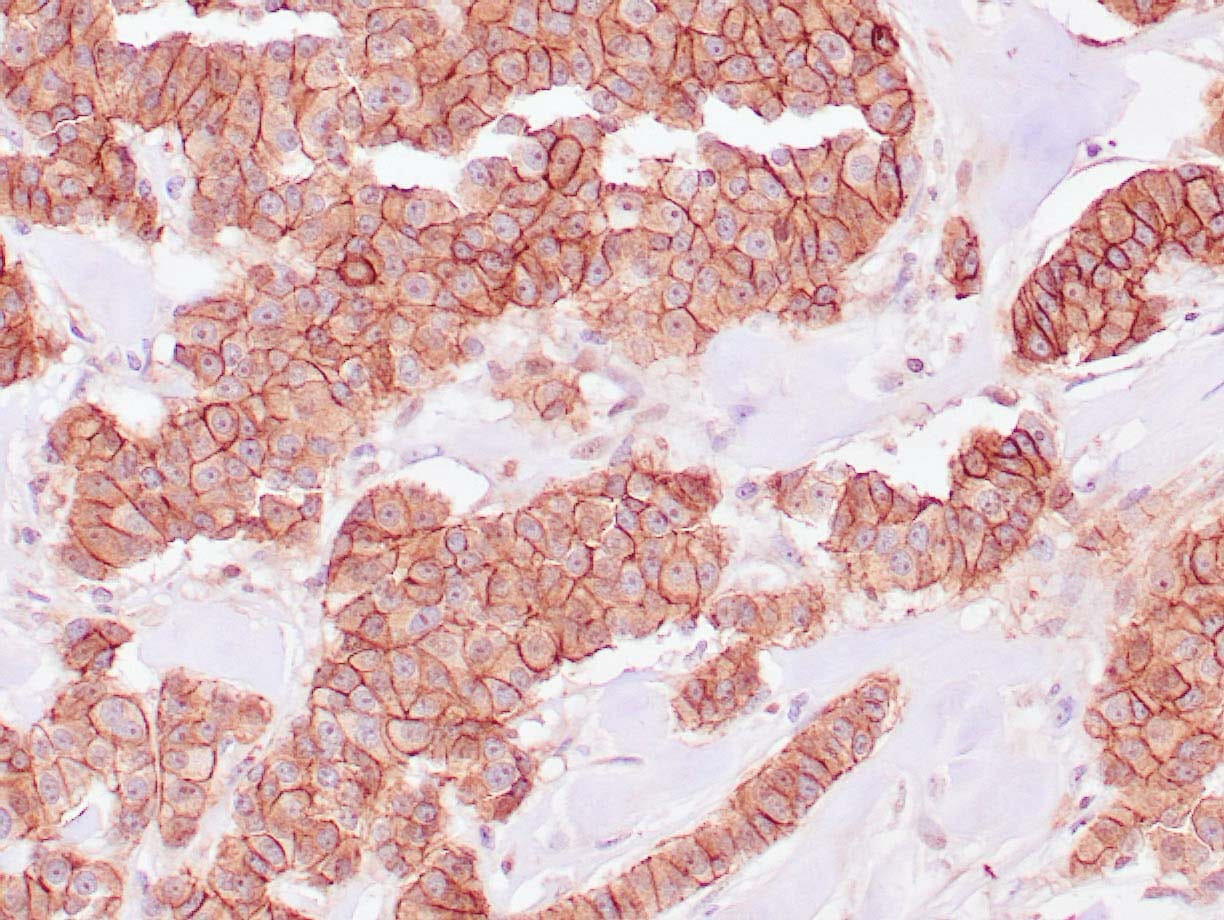 |
| Human infiltrating breast carcinoma stained with anti-E-cadherin antibody using peroxidase-conjugate and DAB chromogen. Note the membrane staining of carcinoma cells. |
Publications
| pmid | title | authors | citation |
|---|---|---|---|
| We haven't added any publications to our database yet. | |||
Protocols
| relevant to this product |
|---|
| IHC |
Documents
| # | SDS | Certificate | |
|---|---|---|---|
| Please enter your product and batch number here to retrieve product datasheet, SDS, and QC information. | |||
Only logged in customers who have purchased this product may leave a review.
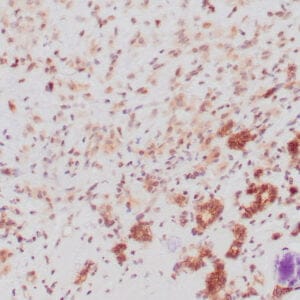

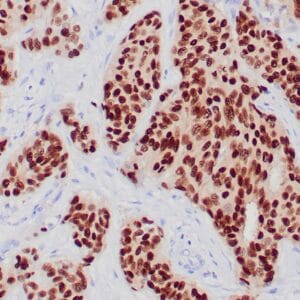
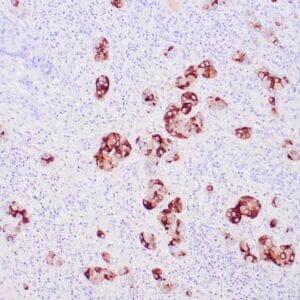
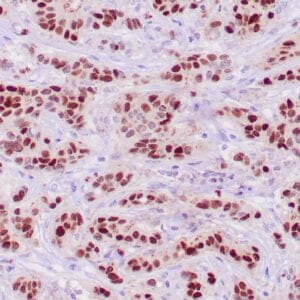
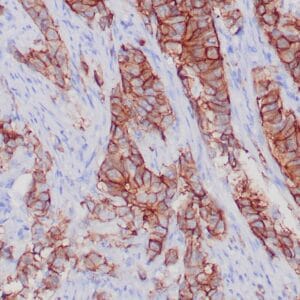

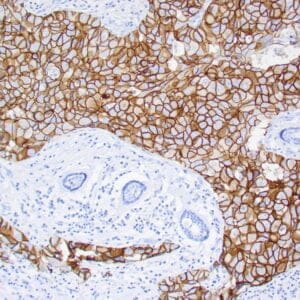
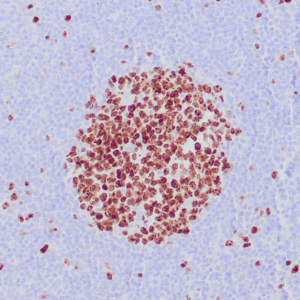
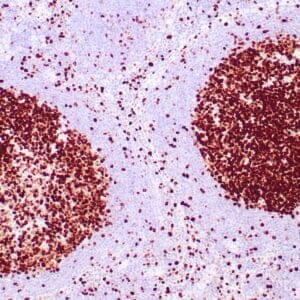
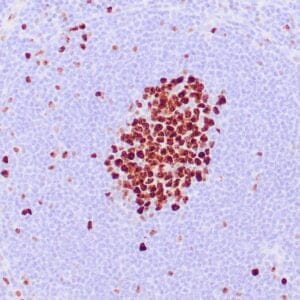
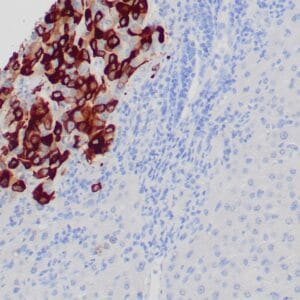
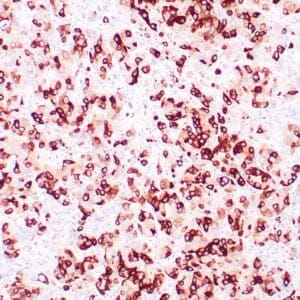
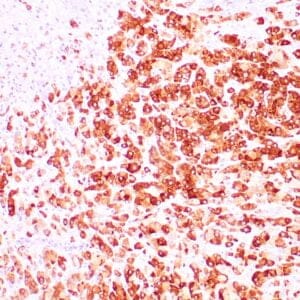

Reviews
There are no reviews yet.